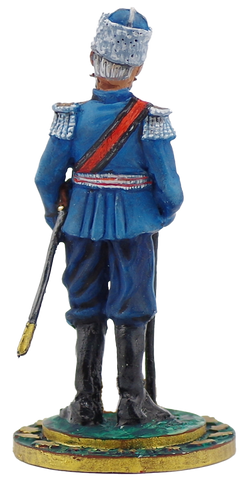
Prince Nikolai Odoyevsky-Maslov
Prince Nikolai Nikolaevich Odoevsky-Maslov (1849-1919) - Russian cavalry general, adjutant general, military ataman of the Don Cossack troops, head of the Moscow Palace Administration, honorary guardian and chairman of the Moscow presence of the Trustee Council of Institutions of the Empress Maria. From the noble family of the Maslovs; Born into the family of captain Nikolai Dmitrievich Maslov and Sofia Ivanovna, née Princess Odoevskaya. By the highest decree of June 30, 1878, you are allowed to add to your surname and coat of arms the surname, coat of arms and title of the extinct family of the Odoevsky princes and be called Prince Odoevsky-Maslov. The coat of arms of Prince Odoevsky-Maslov is included in Part 13 of the General Armorial of the Noble Families of the All-Russian Empire, page 7. He received his education in the Corps of Pages. In service since May 21, 1865, as an officer since 1867, released as a cornet in the Life Guards Horse Regiment. Lieutenant (1871), staff captain (1873), captain (1877). Colonel (1882), commander of the reserve squadron. Commander of the 26th Bug Dragoon Regiment (1892-1896). Major General (1896; distinction) and commander of the Life Guards. Horse Regiment (1896-1901). Commander of the 2nd Brigade of the 2nd Guards Cavalry Division (1901-1903). Commander of the 10th Cavalry Division (1903-1904), then head of the 1st Guards Cavalry Division (1904-1905), Lieutenant General (1904; distinction).


Life Guards Ataman Regiment (in 1891-1917 - Life Guards Ataman Regiment of His Imperial Highness the Sovereign Heir Tsarevich Regiment; colloquial name Ataman Regiment) - Don Cossack regiment as part of the Russian Guard. Formed as part of the Don Cossack troops on April 20, 1775; in 1859 he became a member of the Guards; received its last name in 1878. He was considered exemplary among the Cossack regiments. Traditionally, it was replenished with “Verkhovtsy”: Cossacks from Khopr, from the Upper Don (Nizovtsy traditionally served in the Life Cossack Regiment). The regimental holiday is the day of St. Alexander Nevsky, November 6. Until 1905 it was celebrated on August 30. Don Cossacks are Cossacks who settled along the middle and lower Don. Historically, they lived within the former Don Cossack Host, which was either an independent or an autonomous democratic republic in present-day Southern Russia and parts of the Donbas region, from the end of the 16th century until 1918. Don Cossacks have had a rich military tradition - they played an important part in the historical development of the Russian Empire and participated in most of its major wars.

The House of Odoyev was a princely Rurikid family descended from the sovereign Princes/Dukes of Odoyev and Novosil. Their ancestors were the Upper Oka sovereigns who ruled the tiny Principality of Odoyev until 1494. In the following decade the family was absorbed into the ranks of Muscovite boyars. The Odoyevsky family died out in the mid-19th century. The family was listed in the 5th part ('titled nobility') of the dvoryanstvo registers of the Moscow and Vladimir regions. The princely House of Odoyev dates from 1376, when Prince Roman Semyonovich of Novosil moved his seat from Novosil (in the present-day Oryol Oblast) to Odoyev (in the present-day Tula Oblast) after Mamai's Tatars destroyed the town of Novosil in 1375. According to the Velvet Book, the family traced their lineage from Prince Michael of Chernigov (c. 1185 – 1246), Grand Duke of Kiev and Chernigov, a saint of the Russian Orthodox Church. Up until the late 1400s, the House of Novosil and Odoyev played off Moscow against the Grand Duchy of Lithuania and the Golden Horde. Through the 15th century, the House of Odoyev concluded many treaties with Lithuania under the condition of internal autonomy and independence in their politics towards Moscow and Ryazan. The first appanage prince of Odoyev was Yuriy Romanovich
Odoyevsky, nicknamed "the Black" (d. 1427). In 1494 he submitted to Duke Ivan III of Moscow and the Princes of Odoyev became vassal "serving princes" (sluzhilye kniazya) at the Moscow court. In the late 1500s, the Odoyevsky princes finally lost their principality to Ivan the Terrible (r. 1533–1584) and entered the regular boyar aristocracy. In the 16th and 17th centuries the Odoyevsky family served at the Moscow court as boyars and voivodes. The house produced 13 boyars. The voivodes from the Odoyevsky family participated in many battles of the 16th century, and were especially notable in the battles with the Tatars and in the 1552 Kazanian Campaign of Ivan the Terrible. In the 18th and 19th centuries the Odoyevsky family formed part of the highest aristocracy. However, despite their illustrious background, the members of the family occupied relatively mediocre ranks and offices, becoming (for example) as colonels, ministerial officials and junior generals, while many family members held regular junior officers' ranks. In 1878 the Emperor Alexander II allowed staff-rotmister of the Imperial guards, Nikolay Maslov (1849–1919), the son of Sofia Ivanovna Odoyevskaya, to name himself Odoyevsky-Maslov, and to merge his own coat-of-arms with that of his mother's family to pass it down to his senior male descendants. Later Nikolay Odoyevsky-Maslov became a General of the Cavalry (1914) and the appointed ataman of the Don Cossack troops; however, he also died childless.
Awards: Sash and star of the Imperial Order of Saint Prince Vladimir, Star and cross of the Imperial Order of Saint Anna.






